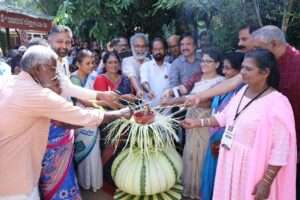 Making it in Michigan: Conference and Trade Show
Making it in Michigan: Conference and Trade Show
12 November 2013, Michigan State University, Michigan, USA
Aspiring entrepreneurs would need capacity building, links to support and services and interactions with other entrepreneurs at different stages of value chain. The Conference and Trade Show on ‘Making it in Michigan’ organized by The Product Centre of Michigan State University (MSU), Michigan, USA on 12th November 2013 was such an event that aimed at promoting, facilitating and encouraging entrepreneurs, who have enterprises on food products. Dr. R.Venkattakumar, Principal Scientist, Extension Systems Management Division, National Academy of Agricultural Research Management (NAARM) shares his experiences of participating in this programme at Lansing Centre, Lansing, Michigan, USA.
As an international scholar working on ‘Promotion of entrepreneurship in agriculture’ at World Technology Access (WorldTAP) Programme at College of Agriculture and Natural Resources, Michigan State University (MSU) during August‐November 2013, I had an opportunity to participate in this conference and trade show organized by MSU Product Centre (Box 1).
MSU Product Centre implements a programme on ‘Made in Michigan’ to encourage the entrepreneurs who do business on local made food products of Michigan. MSU Product Center extends support services to network these entrepreneurs with other players of supply chain. In that way, the centre organizes annual events. Thus, it was the sixth annual meeting of ‘Making It In Michigan Conference and Premier Specialty Food Show’. It was also a programme to commemorate the 10th Anniversary of establishment of ‘MSU Product Centre’. The programme was a one‐day event that had educational sessions that brought together leading Michigan experts to guide participant entrepreneurs in refining and growing their businesses, strategizing their entry into retail sales; designing their product label and retail sales tools and obtaining legal protection for their business and their product including patents, trade secrets and trademarks and getting food product licensing by the State of Michigan.
Box 1: MSU Product Center
The MSU Product Center was established in 2003 by MSU College of Agricultural and Natural Resources (CANR), MSU Extension and MSU AgBioResearch. It focuses on assisting entrepreneurs who develop and commercialize high‐value, consumer‐responsive products and businesses related to agricultural and foodbased products. The members of Product Center’s Innovation Counselor Network are strategically positioned around Michigan. They assess the developmental phase of the project of clients, facilitate them identify markets, innovate new products, make critical decisions and guide from concept to launch.
Product Center’s ‘Concept Definition’ team helps entrepreneurs decide if their concept is something they want to pursue; if they have already developed their concept, ‘Venture Development’ centre helps them create a business plan; if they have already developed their product but need assistance with nutritional facts, labeling or meeting Federal Food and Drug Administration requirements, the team provides assistance on a fee. MSU ‘Client Services’ locates the entrepreneurs about necessary resources at MSU as well as at state and federal agencies and private companies to move projects forward.
The center also has initiated a new line of program directed towards existing Stage 2 businesses that have sustainable revenue and are looking to make major expansions in sales and production. This new initiative is named the High Impact Venture Action Team or HI‐VAT. Since 2004, the centre organized 24184 one‐toone counseling for aspiring entrepreneurs, facilitated 2125 entrepreneurs towards concept development, 1232 towards business expansion, 1200 towards specialized services and successfully launched 254 business ventures (http://productcenter.msu.edu/about).
WHAT I LEARNT
- How to protect, enhance and refresh your brand?
The theme of the key‐note address was ‘How to protect, enhance and refresh your brand?’ that was delivered by Mr. Tim McIntyre, Vice President‐Communications, Domino’s Pizza. He explained about how the brand positioning of Domino’s Pizza was shifted from ‘service’ to ‘taste’ to be in the race of American market. Mr. Tim also shared his experience in protecting the Domino’s brand value through effective utilization of social media, when it was questioned by its own franchise retailers. He also explained how such a bad ‘crisis’ was effectively utilized by Domino’s Pizza towards brand promotion.
He informed that introducing innovations with radical changes and not incremental changes and embracing transparency by becoming part of the day‐to‐day conversations of the consumers through social media are the two important strategies followed by Domino’s pizza to enhance and refresh the image of their brand. Online retailing is one of the best opportunities to reach‐out larger consumer community and Domino’s Pizza is one of the leading American food brands to effectively utilize online retailing.
2. How to start retail business? (Retail opportunities for entrepreneurs)
Awareness creation among the consumers about local food products and their significance to the American food system is important to promote local food products as well the local entrepreneurs. The best mode to popularize such food products is making the consumers to ‘try’ the product through ‘sampling or free trail or demo’ services at different retail centres on the basis that once, the customers are satisfied with the ‘sampling’, they will be very much loyal to the brand. Hence, attractive sampling may be the best method to attract loyal customers. Three hours of ‘sampling’ the product at retail stores may be sufficient for creating awareness creation.
The product label need to have company and product description, source of product and nutrient ingredients etc. There is no fee is collected for ‘sampling’ done by the local entrepreneurs. Having information about the nutrient ingredients in the label is very important for both sampling and sale. Similarly, more margins have been given by the supply‐chain players for the ‘Michigan’ made products in order to promote local entrepreneurs. Shelf life of the product is an essential criterion for movement of the product. Hence, information about this criterion on the label may be useful in moving the product sales.
The ‘local made foods’ have become trendy than the ‘organic foods’. Hence, promoting local entrepreneurs has become profitable too. There are two bar codes used towards retail sales of food products. One is global permission (GP) code and the other is a generic code. Getting access to the distribution network is the most difficult aspect in promoting entrepreneurship. In such scenario, organizing ‘business cooperatives’ among the entrepreneurs is one of the options for effective distribution of food products. Entrepreneurs may also come together to understand their strength and weaknesses and accordingly plan appropriate partnerships to do the business.
Speech by Mr. Tim, VP- Educational sessions for entrepreneursCommunications, Domino’s
3. Obtaining legal protection for product and business
Regular payment of taxes, managing liquidity and insurance cover from risks are the best ways to protect the business. Brand, innovation, trade secrets and business know‐how are the intangible assets of company. These intangible assets can be protected through intellectual property tools such as patents, trademarks, trade secrets and copy rights. Trademark is a frequently used IP tool to protect food businesses. Trademark Electronic Search System (TESS) database facilitates trademark search before deciding the trade mark for the businesses. Business trademarks can be obtained either for name or for design/ logo.
Strong brand and uniqueness provides strong trademark. US Patent Office provides idea for selecting brand names and trademarks (http://www.uspto.gov/trademark/). There are three types of patents can be used in food businesses. Utility patents are obtained for functional properties; design patents are obtained for product designs and plant patents are obtained for distinct or new variety of plants or asexual propagation methods of plant varieties that are used for food products.
4. Marketplace Trade Show
The ‘Marketplace trade show’ organized after the lunch session featured over 150 new and existing businesses. The entrepreneurs and business players of Michigan were allowed to show case their products among the general public. The trade show was free to the general public. The entrepreneurs who got awards for 2013 were provided with special pavilions at trade show. There were also provisions for cooking demonstrations for preparation of local recipes and food products in front of the general public. This event was followed by announcement of awards for the winners of the tradeshow.
Trade show photoes
FINAL IMPRESSIONS
- ‘MSU Product Centre’ model of MSU is best to promote aspiring youth and entrepreneurs as successful business players through ‘concept development, venture development, client services, HIVAT and Strategic Market Institute’ strategies. This model can very well be piloted in selected State Agricultural Universities (SAU) to promote agricultural and food‐based enterprises.
- Promoting local food products provide opportunities for popularizing local agricultural produce, the local preparations and recipes. Thus ultimately the local farmers and local entrepreneurs are benefitted. In India, there is a rich tradition of local‐made foods and recipes prepared from local agricultural produce. Promoting the local food in India thus may bring‐in the profitability, the immediate need of Indian agriculture.
- Networking among entrepreneurs, retail chain operators, wholesale players, legal advisors, financiers etc. through the platforms similar to ‘Making it in Michigan’ provides opportunities for entrepreneurs for further business expansion.
- Discussion‐based education by the experts, educators and counsellors who are actually involved in promotion of food enterprises facilitates effective learning, networking and business promotion.
- Awards for entrepreneurs such as ‘best start‐up entrepreneurs’, ‘barrier‐buster entrepreneur’, ‘value‐added agripreneurs’ and ‘entrepreneurs of the year’ were encouraging and motivating the other entrepreneurs who were the audience.
The trade show was effective in creating a platform for successful communication between entrepreneurs and consumers. Similarly, the awards for best stalls in the trade show also were motivating to the participating entrepreneurs.





Add Comment